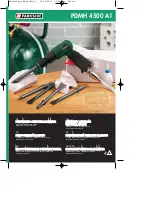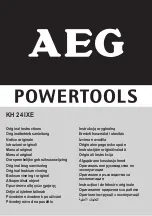
21
OPERATION MODE SWITCH
Rotary hammer is equipped with 2 position switch of the working mode (
6
). Depending on its setting,
drilling only or impact drilling is possible. Press the lock button ‚a’ prior change of position of the operation
mode switch (
6
) (
fig. E
).
●
Pos O
– regular drilling (symbol of a drill)
●
Pos I
– impact drilling (symbol of a drill and a hammer)
Do not try to change position of the working mode switch when the rotary hammer motor is
operating. Such action may lead to serious damage of the rotary hammer, or even injury of the
user. Do not use three jaw drill chuck when the rotary hammer is set to impact drilling. This chuck is
designed for regular drilling only (in wood or steel).
LEFT – RIGHT DIRECTION OF ROTATION
Choose direction of rotary hammer spindle rotation with the selector switch (
3
). When setting direction of
rotation, refer to graphic symbols located on the tool body.
●
Clockwise rotation
– set the direction selector switch (
3
) to proper position.
●
Counter-clockwise rotation
– set the direction selector switch (
3
) to proper position (
fig. F
).
Do not change direction of rotation when the spindle of the rotary hammer is rotating. Check if the
position of the selector switch is correct before starting the tool. Do not use left direction of rotation
when impact function is on.
DRILLING HOLES
●
When drilling a hole with large diameter, it is recommended to drill smaller hole and then ream it to
desired diameter. It prevents overloading the rotary hammer.
●
When drilling deep holes drill gradually to smaller depths, then slide the drill out of the hole to remove
chips and dust.
●
If a drill jam occurs during drilling, the overload clutch will disengage. Turn off the rotary hammer
immediately to prevent its damage. Remove jammed drill from the hole.
●
Keep the rotary hammer in the axis of the hole. Keeping the drill perpendicular to the surface of the
processed material ensures the most effective operation. If drill is not kept perpendicular to the surface
during operation, it may get jammed or broken in the hole.
Long lasting drilling at low rotational speed of the spindle may cause motor overheating. Provide
regular breaks during operation or let the tool operate at maximum speed with no load for
approximately 3 minutes. Do not cover holes for motor ventilation in the rotary hammer body.
DRILLING WITHOUT IMPACT
Materials like steel, wood and plastics can be drilled with rotary hammer with use of three jaw drill chuck
with intermediate adapter. Mount together three jaw chuck and adapter by thread joint and then place it
in the rotary hammer chuck (proceed like with SDS-Plus drills) (
fig. G
).
Use drills of high speed steel or carbon steels (only for wood and wood-like materials).
Do not use three jaw drill chuck when the rotary hammer is set to impact drilling. This chuck is
designed for regular drilling only (in wood or steel).
IMPACT DRILLING
To get the best results for drilling use high quality drills with sintered carbide inserts.
Dust produced during renovation and construction works is harmful. To limit its adverse effects it is
recommended to use anti dust mask and provide good ventilation of the workplace.
●
Choose appropriate mode of drilling, impact drilling in this case.
●
Insert appropriate drill with SDS-Plus shank into the chuck (
1
).
●
Press the drill against processed material.
●
Switch on the rotary hammer (the rotary hammer mechanism should operate smoothly and the
working tool should not bounce on the processed material surface).
●
Increase speed when needed by pressing the switch button (
5
).
Summary of Contents for 59GP500
Page 2: ...2...
Page 4: ...4...
Page 6: ...6 1 2 8 6 5 3 4 7...
Page 7: ...7 F 3 7 8 A B C 2 1 A 5 D 4 P R E S S E 6 a G 2 1...
Page 8: ...8...
Page 31: ...31 59GP500...
Page 32: ...32 1 2 3 4 5 6 1 2 II 3 4 5 6 II 1 SDS Plus 2 3 4 5 6 7 8 1 1 2 1 3 1 4 1 5 3 6 1 7 1 8 1...
Page 33: ...33 12 7 7 7 7 8 7 A 8 7 7 8 7 SDS Plus B clic clic 2 1 C 2 1 2 2 1...
Page 34: ...34 5 5 5 4 D 4 5 5 2 6 6 a E O I 3 3 3 F...
Page 35: ...35 3 SDS Plus G 1 SDS Plus 5...
Page 36: ...36 2 3 5 230 AC 50 440 0 1500 1 0 5000 1 1 2 SDS Plus...
Page 38: ...38 59GP500...
Page 39: ...39 1 2 3 4 5 6 1 2 3 4 5 6 II 1 SDS PLUS 2 3 4 5 6 7 8 1 1 2 1 3 1 4 1 5 3 6 1 7 1 8 1...
Page 40: ...40 12 7 7 7 7 8 7 A 8 7 7 8 7 SDS Plus B clic clic 2 1 2 1 2 2 1...
Page 41: ...41 5 5 5 4 D 4 5 5 2 6 6 a O I 3 3 3 F...
Page 42: ...42 3 SDS Plus G 1 SDS PLUS 5 2 3...
Page 43: ...43 5 230 50 440 0 1500 1 0 5000 1 1 2 SDS Plus 13 18 24 II 2 3 2015...
Page 97: ...97 59GP500...
Page 98: ...98 1 2 3 4 5 6 1 2 3 4 5 6 II 1 SDS Plus 2 3 4 5 6 7 8 1 1 2 1 3 1 4 1 5 3 6 1 7 1 8 1...
Page 99: ...99 12 7 7 7 7 8 7 A 8 7 7 8 7 SDS Plus B clic clic 2 1 2 1 2...
Page 100: ...100 2 1 5 5 5 4 D 4 5 5 2 6 6 a E Poz O Poz I 3 3 3 F...
Page 101: ...101 3 SDS Plus G W 1 SDS Plus 5...
Page 102: ...102 2 3 5 230 V AC 50 Hz 440 W 0 1500 min 1 0 5000 min 1 1 2J SDS Plus...
Page 117: ...117 59GP500...
Page 118: ...118 1 2 3 4 5 6 1 2 II 3 4 5 6 II 1 SDS Plus 2 3 4 5 6 7 8 1 1 2 1 3 1 4 1 5 3 6 1 7 1 8 1...
Page 119: ...119 1 12 7 7 7 7 8 7 A 8 7 7 8 7 SDS Plus clic clic 2 1 C 2 1 2 2...
Page 120: ...120 2 1 5 5 5 4 D 4 5 5 2 6 6 a E 3 3 3 F...
Page 121: ...121 3 SDS Plus G 1 SDS Plus 5...
Page 122: ...122 2 3 5...
Page 145: ...145...
Page 146: ...146...
Page 147: ...147...
Page 148: ...graphitepro pl...
















































